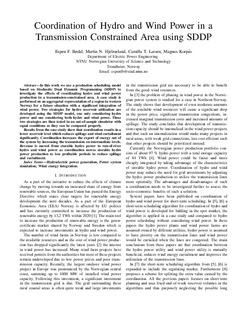Coordination of Hydro and Wind Power in a Transmission Constrained Area using SDDP
Chapter, Peer reviewed
Accepted version
Permanent lenke
http://hdl.handle.net/11250/2471602Utgivelsesdato
2017Metadata
Vis full innførselSamlinger
- Institutt for elkraftteknikk [2443]
- Publikasjoner fra CRIStin - NTNU [37703]
Originalversjon
10.1109/UPEC.2016.8114017Sammendrag
In this work we use a production scheduling model based on Stochastic Dual Dynamic Programming (SDDP) to investigate the effects of coordinating hydro and wind power production in a transmission-constrained area. A case study is performed on an aggregated representation of a region in western Norway for a future situation with a significant integration of wind power. Two strategies for hydro reservoir utilization are developed using the SDDP model, one only considering hydro power and one considering both hydro and wind power. These two strategies are then tested in an out-of-sample simulator with equal conditions so they can be compared properly. Results from the case study show that coordination results in a lower reservoir level which reduces spillage and wind curtailment significantly. Coordination increases the export of energy out of the system by increasing the transmission on intermediate levels. Revenue is moved from storable hydro power to run-of-river hydro and wind power as coordination moves storable hydro power production to less profitable periods to reduce spillage and curtailment.
